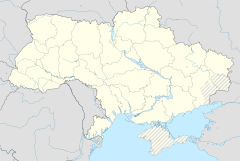Odesa Quarantine
| Odesa Quarantine | |
|---|---|
Одеський карантин | |
 | |
| Alternative names | Quarantine Walls |
| General information | |
| Location | Odesa, Ukraine |
| Coordinates | 46°28′56″N 30°45′17″E / 46.48222°N 30.75472°E |
| Year(s) built | 1793 |
The Odesa Quarantine (Ukrainian: Одеський карантин, romanized: Odeskyi karantyn) is a lazaretto located on Cape Langeron in the city of Odesa, Ukraine. Located adjacent to Shevchenko Park, the structure was historically used for preventing the spread of plague before being largely demolished in the late 19th century.
History
[edit]
The modern Odesa Quarantine was established in 1811 on the basis of the Odesa Fortress, a defence line which had been constructed in 1793.[1] The establishment of the Quarantine coincided with a plague outbreak,[2] and it was established under the guidance of Armand Emmanuel de Vignerot du Plessis, 5th Duke of Richelieu.[3] The original quarantine was built alongside the Port of Odesa by François Sainte de Wollant. It was at first very successful, but its wooden structure soon proved to be unable to cope with the increasing development of the city, and the quarantine was moved.[3]
Following its establishment, the quarantine was subject to criticism by merchants, with a British consul noting that "the real and ostensible evil has been the necessity for restraints to intercourse and business." Quarantine laws were later loosened and temporarily abolished during the Crimean War, but would frequently be reinstated as part of protectionist policies.[4] Following the abolition of quarantine laws and the transfer of quarantine functions to hospitals, the Odesa Quarantine was largely demolished in 1896. The powder tower, the arcade, and a partially-intact tower of the Quarantine Cemetery have survived from the original structure.[3] The quarantine was later a site for executions of participants in the Russian Revolution of 1905.[5]
The Quarantine Cemetery was destroyed in 1936 and Chornomorets Stadium was built over its place.[1] Other threats to the quarantine's existence include the development of Trams in Odesa.[5] Beginning in 2014, the local government of Odesa has made efforts to restore the quarantine's appearance. Cannons from the Russo-Turkish War of 1877–1878 have also been placed on the quarantine for decorative purposes.[6]
References
[edit]- ^ a b "Карантинний цвинтар (Цвинтар Одеського Портового Карантину)" [Quarantine Cemetery (Cemetery of Odesa Port Quarantine)]. Odesa's Places of Sorrow (in Ukrainian). Retrieved 20 February 2024.
- ^ Grigoriantz, Alexandre (5 May 2020). "L'épidémie de peste d'Odessa de 1811 vue par des nobles français qui l'ont vécue". Le Figaro (in French). Retrieved 20 January 2024.
- ^ a b c "The story of Quarantine Wall". The Odessa Journal. 23 January 2021. Retrieved 20 February 2024.
- ^ Durand, Olivia (8 April 2020). "Quarantine used to be a normal part of life – and wasn't much liked then, either". Faculty of History, University of Oxford. Retrieved 20 January 2024.
- ^ a b "ЦПКиО: парк культуры, а не паркинг" [Central Park of Culture and Recreation: a park of culture, but no parking]. Eternal Odesa (in Russian). 6 October 2011. Retrieved 20 February 2024.
- ^ "Quarantine wall, Odessa". IGotoWorld.com. Retrieved 20 February 2024.


